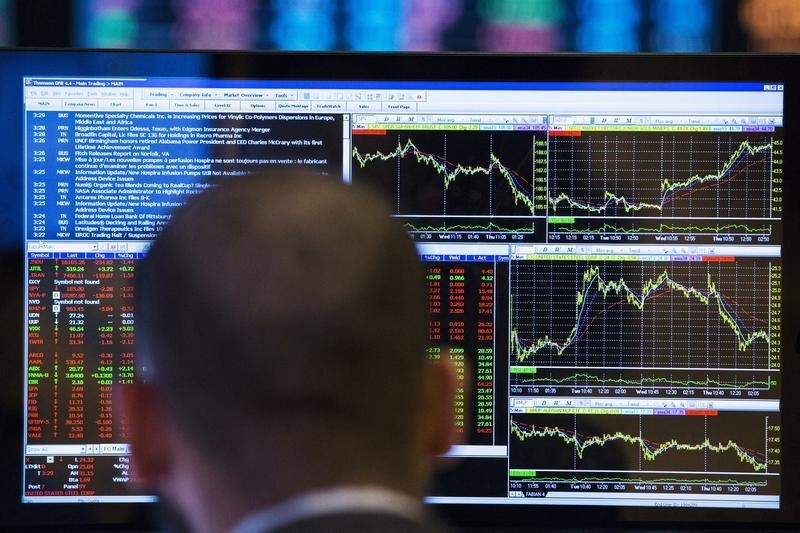© Reuters. FILE PHOTO: A projection shows a 100 franc banknote in a window in Zurich, Switzerland December 16, 2021. REUTERS/Arnd Wiegmann/File Photo
By Naomi Rovnick and John Revill
LONDON/ZURICH (Reuters) – The potential for the Israel-Hamas conflict to worsen and poor corporate earnings have sent investors scrambling for safety with few havens left, as high-for-longer U.S. rate expectations batter government bonds and the yen.
Enter the Swiss franc, a longstanding safe haven asset thatjust hit its highest level against the euro since 2015, standing tall as its traditional rivals lose appeal.
Disappointing financial updates from the likes of European food giant Nestle and U.S. bank Morgan Stanley have added to investors’ risk-off mood. Global shares are down 1.6% this week, while Wall Street stocks lost 2% in two sessions.
“Markets are caught between a rock and a hard place, with a surge in risk aversion where bonds provide no protection,” said Florian Ielpo, head of macro at Lombard Odier Investment Managers in Geneva. “Where do you express that risk aversion when you can’t express it in bonds?”
Other than U.S. dollar cash, only the Swiss franc and gold remained as options, Ielpo said.
The euro dropped to 0.9419 francs on Friday, its lowest since the Swiss National Bank scrapped the franc’s peg to the euro in January 2015, down about 2.4% against the currency so far this month.
The dollar has weakened around 1% against the franc this week, and is set for its biggest weekly drop since July.
In contrast, the dollar is at its highest in nearly a year against the Japanese yen – another traditional safe haven – with 10-year Treasury yields touching 5% for the first time in 16 years draw money away from the low-yielding curency.
Traders also perceive a greater risk of currency intervention by Japanese authorities, and resulting volatility, that any Swiss action, analysts said.
The Swiss franc has rallied over 3% against the yen this month.
“It is the differential fear between running into the Swiss authorities and the (Ministry of Finance) in Japan that is certainly magnifying the strength for the ,” CIBC Capital Markets head of G10 currency strategy Jeremy Stretch said.
UNCERTAIN WORLD
Since the Oct.7 Hamas attacks in Israel, the Swiss franc — also referred to as the Swissie — has rallied roughly 2% against the dollar.
In contrast, the , which measures its value against a basket of currencies, is broadly steady.
“The war in the Middle East clearly has lead to a flight to safety that benefited the Swiss franc,” said Karsten Junius, an economist at J.Safra Sarasin in Zurich.
ING currency strategist Francesco Pesole said the next big level for euro/Swiss franc was 94 with a near-term move to 93 possible given heightened geopolitical tensions.
Still, sharp currency moves could attract the attention of the central bank, given that big daily swings are becoming more frequent.
For example, the euro fell 0.89% against the franc on Oct. 13, its biggest daily drop since November 2022.
The Swiss National Bank declined to comment on Friday about the currency’s value or possible interventions.
Since late 2022, it has been buying francs to prop it up, reducing the inflationary impact of rising costs of commodity imports.
Some analysts said the SNB, viewed as hard to predict since it roiled currency markets in 2015, may have one eye on abandoning currency support if exporters complain too loudly.
“A too fast and large appreciation of the franc would be very difficult for Swiss exporters,” J.Safra Sarassin’s Junius said.
But Pictet Asset Management chief strategist Luca Paolini, said Switzerland’s high-value export industry was competitive enough to withstand currency strength.
The SNB “will react only if the strength of the franc creates a situation where deflation risk is very significant and we’re not there now,” Paolini said.
Economists polled by Reuters see Swiss inflation falling to 1.5% in 2024, from 1.7% currently and well within the central bank’s 0-2% target range.
The Swiss currency could come under pressure if the U.S. economy slipped into recession and U.S. Treasuries regained their luster, said Toby Gibb, investment director at Artemis, though he judged such a scenario as unlikely.
“Ultimately there is little reason to believe that in the current environment of resilient economic performance, strong labour force dynamics and sticky core inflation that yields should fall meaningfully,” he said.
Read the full article here












